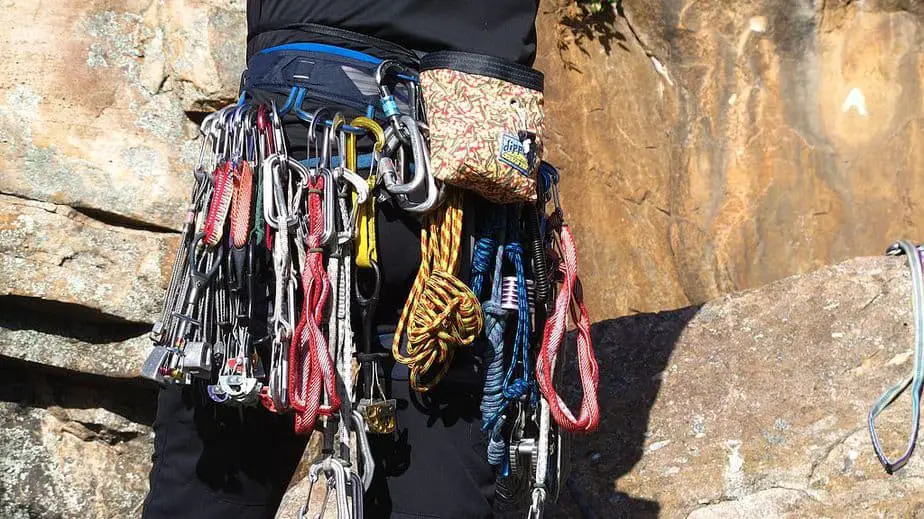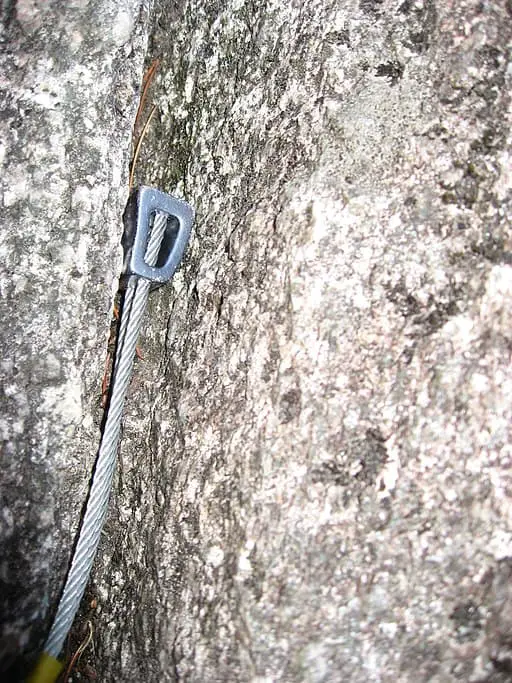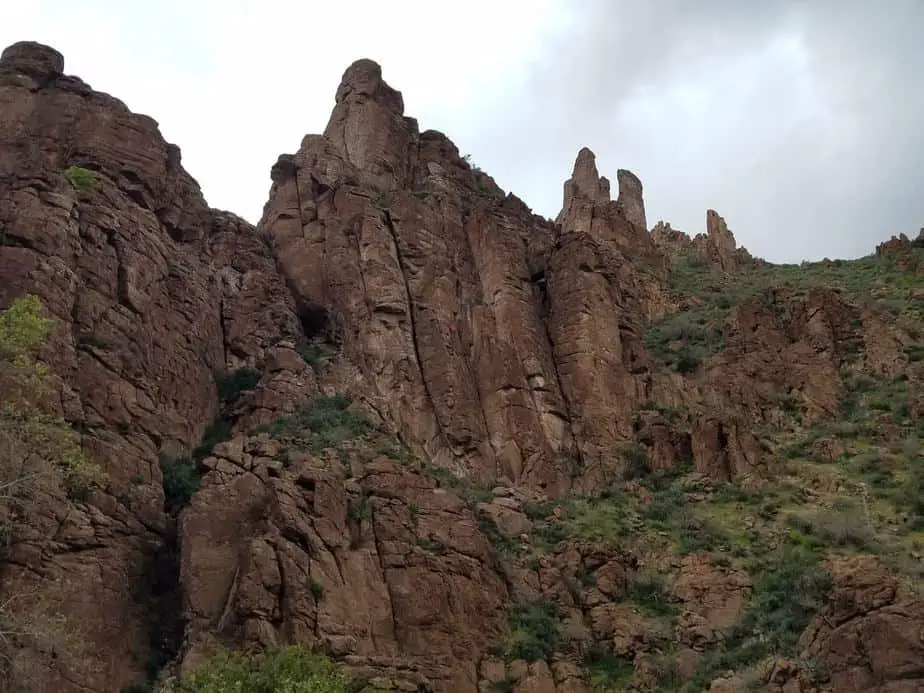Trad climbing, short for “traditional” climbing, is considered by many to be the purest form of climbing. Because trad climbing relies on placing removable gear, it gives climbers the ability to access inaccessible places without scarring or permanently damaging the rock. Trad climbing is often thought of as a more dangerous form of climbing because the gear placements aren’t permanent.
Trad climbing is more dangerous than sport climbing because the gear isn’t permanent and can slip if placed incorrectly. Additionally, you can only place protection where the rock allows it, so sometimes there are large, dangerous runouts between pieces.
Climbing consists of manageable risks and unmanageable risks. For example, a climber can avoid falling by using a belay and tying a stopper knot in the end of a rope; however there is always the minute possibliity that a sharp rock could fall and sever that rope. Fortunately, many of the inherent dangers can be mitigated through effective risk management practices.
How Dangerous is Trad Climbing?
All climbing carries inherent risk and should be considered dangerous. Even bouldering is dangerous , because every fall means impacting the ground. While many people consider trad climbing to be more dangerous than sport climbing because there are no bolts, it’s important to remember that climbing gear is NOT the only thing that keeps you safe!
, because every fall means impacting the ground. While many people consider trad climbing to be more dangerous than sport climbing because there are no bolts, it’s important to remember that climbing gear is NOT the only thing that keeps you safe!
Poor rock quality, hazards on the wall, and lowering/rappelling miscommunications can all occur just as easily on a sport climb as on a trad climb.
This doesn’t mean that trad climbing is always more dangerous than sport climbing; for example, climbing a 5.6 trad route with bomber gear placement is certainly safer than climbing a 5.11 X sport route with runout bolts and loose anchors.
A very experienced and cautious trad climber is probably less likely to get hurt than a novice (or inebriated) sport climber. But generally, an equivalent sport route is safer than a trad route.
What Makes Trad More Dangerous Than Sport?
Gear Pops Out
The biggest fear that sport climbers have when learning trad is that they have a hard time trusting the gear to hold if they take a fall. Newbie climbers go through the same sort of thing when learning to trust bolts, ropes, and carabiners.
Different types of trad gear have different force ratings, but generally speaking, trad gear can handle similar forces produced by a fall that bolts can handle. However, bolts are often placed by an experienced climber who has extensive knowledge of the rock, the direction the climb will go, and other factors that contribute to the safety of the climb.
When placing trad gear, all of those factors need to be considered by the climber during each placement. While experienced trad climbers trust their gear as much as bolts, new trad leaders should be extremely careful, and not expect their first placements to be as reliable as the average bolt.

Getting Off Route
Trad climbing is a lot more adventurous than sport climbing, in that a climber can’t always identify the exact path forward from the ground up. Routes can wander, sometimes significantly, in order to follow the natural features of the rock.
The is different from sport climbing, where a climber can often look up at the wall and see exactly where the bolts go. This makes it more likely that the trad leader will get off route and take a whipper or even pendulum.
Increased Rope Drag
Along with the wandering routes comes the likelihood of increased rope drag. As the rope goes back and forth, almost spider webbing between pieces of pro, it can create a lot of drag that pulls down on the leader. Added weight makes climbing that much harder and makes you more likely to slip.
Heavy Trad Rack
Trad gear can get really heavy, really quickly. Leaders usually only take what they think they’ll need for a pitch, but it can add up fast. I wrote about the Beal Birdie and how it’s a great substitute for the Petzl GriGri, but lots of trad climbers argue that the added weight (35g, or as much as a lightbulb) isn’t worth it. Between nuts, cams, and anchor equipment, leading a trad pitch packs on a lot of extra weight and makes you more likely to slip.
and how it’s a great substitute for the Petzl GriGri, but lots of trad climbers argue that the added weight (35g, or as much as a lightbulb) isn’t worth it. Between nuts, cams, and anchor equipment, leading a trad pitch packs on a lot of extra weight and makes you more likely to slip.

Piece Availability
While more popular routes include an exact description of every piece you’ll need, many routes require judgement from the ground up. The leader loads up their harness with what they think they’ll need, and then has to make it work. This can mean they won’t always have the best piece for the slot.
You can’t carry everything with you, so you have to make do with what you’ve got. There’s also always the risk of dropping pieces as you go to place them. Not only do you lose a piece of gear that may be necessary for the pitch, but you could drop it on your belayer.
Long Runouts Between Gear
With sport climbing, whoever bolts a route can place bolts as close together as they want. Bolts can go into overhung, sheer faces that could never fit a nut or cam. Trad climbing uses the natural features of the rock to protect the climber, which means there are only specific places pro can be placed.
This can often lead to runout stretches of featureless rock between pieces where a fall can be dangerous. In popular climbing areas, these sections are often supplemented with a single permanent bolt.
Tips for Safe Trad Climbing
If you’re interested in trad climbing, it’s important to recognize that while it is a dangerous activity, the risks are often very identifiable and manageable. The dangers of trad climbing can be mitigated through proper instruction, lots of practice, and accurate self-assessment of ability.
Proper Instruction
It is a crucial step in the trad climbing growth process to receive instruction from another climber who is more experienced. There are two main ways to find this kind of instruction:
Guide Service:
Hiring a guide is a great way to learn the basics of trad climbing. Often a guide will tailor a client’s trip to expose them to what the client is interested in. A good guide should be certified by the AMGA or another reputable organization, and are often a part of a larger guiding service.
If you decide to hire a guide, you can search for guiding services near major climbing destinations. Make sure to express your interest in trad climbing to your guide. They will likely be happy to explain what they’re doing while climbing and introduce you to the basics.
While hiring a guide can be expensive, it will provide you with a verified climbing partner who is both knowledgeable and certified to pass on good information and keep you safe.
Mentor:
Some climbers are lucky enough to be mentored by a more experienced climber. This is often a very mutualistic relationship: the mentor has a willing climbing partner, and the mentee is able to gain experience and knowledge while following their mentor on climbs that would otherwise be outside of their skill level.
If you find yourself climbing with an experienced partner, remember that you aren’t paying them to show you a good time! Once you’re out climbing, come ready to learn, keep up as best as possible, and ask questions. Paying for gas or for post-send beers is always a nice gesture too!
Practice
Once you’ve started learning the basics of trad climbing from a guide or mentor, the next step to mitigating the dangers of trad climbing is to practice, practice, practice! The two most important skills in trad climbing are recognizing and placing good gear, and climbing/placing efficiently.
These skills should be practiced on the ground first before you get on an actual climb. Here are some tips on how to practice these skills:
Recognizing and Placing Good Gear
At Home:
- Grab your gear and walk around your house or yard looking for “cracks”. You’ll be surprised how many potential placements you will find! Check places like around appliances or furniture, between bricks on a wall, or even in horizontal cracks in a driveway or sidewalk.
- At each potential placement, try many different sizes of gear and see if they fit. This exercise will help you get better at looking for gear placements as you get familiar with the different sizes of gear on your rack.
At the Crag :
- Spend time walking around the base of routes or boulders, repeating what you practiced at home, and find different cracks and features in the rock that could be a potential placement opportunity.
- Start learning about rock quality, and how it can affect your gear. Recognizing potential hazards such as breathing flakes, loose blocks, and flaring cracks are an important part of making safe placements.
- Start “weighting” your gear from stances on the ground to test how good your placements are. You can do this by placing gear at eye-level, clipping a sling to the carabiner, and hanging on it. Afterwards, inspect the gear and see if it has moved or changed orientation at all. This process will help you understand how well you are placing gear from the safety of the ground.
- Following trad climbs and removing well-placed gear is ultimately the best way to learn about gear placement. When following or cleaning a trad route put up by your guide or mentor, pay close attention to what gear they placed, how it was placed, and how easy it was to remove the gear. Always ask questions if you don’t understand why something was done a certain way!

Climbing/Placing Efficiently
At Home:
- Put on your harness and practice different ways of racking your gear. There is no one right way to do this, so figure out what works best for you. The most important part of racking your gear is making sure you know what gear you have and where it is on your harness, so you can grab what you need and place it efficiently.
At the Crag:
- Practice placing gear while on top-rope. Find a crag where you can set up some top-ropes on crack climbs (this is also something your guide or mentor can do for you if you don’t have access to a crag with walk-up anchors). The only way to get more efficient when placing gear to place a LOT of gear, so don’t rush this step!
- Work on climbing quickly, picking the right piece of gear first, and placing from a rest. These skills will allow you to save your strength and feel confident on the route when you start leading.
Accurate Self-Assessment
Accurately assessing your own abilities and motivations is both the most nuanced and ultimately most important skill for making trad climbing less dangerous. If your goal when trad climbing is to impress others, climb at your max grade, or progress through the grades rapidly, you are putting yourself and others at risk.
Never let your ego get the best of you when trad climbing! Here are some tips to make sure you’re able to accurately assess your own abilities:
Keep a Climbing Journal
- Writing down what you climb at the gym or while bouldering or sport climbing outdoors can give you a realistic picture of what grades you climb consistently.
Climb Below Your Max Grade
- The safest way to climb in any discipline is to not fall, so especially when you start leading your first trad climbs, choose routes that are well within your comfort zone. You do NOT want to be getting pumped out or be afraid of falling when you’re making your first trad placements on lead.
Enjoy the Process
- In climbing, it’s easy to focus on just the grade or getting the “send”. Don’t forget to enjoy the learning process, as well as the beautiful places that trad climbing will take you!
- A great day out on the rock for you and your partner is dependent on you both feeling safe and confident. Don’t ever sacrifice your safety by being dishonest about your experience level or trying to impress someone else. Be humble, place good gear, and have fun!

Related Questions
Is trad climbing the most dangerous form of climbing? Trad climbing is generally more dangerous than sport climbing or bouldering, but less dangerous than extreme forms of climbing like free soloing or even ice climbing. The difficulty of the route, experience of the climber, and the quality of the rock also affect the safety factor.
Is trad gear less trustworthy than bolts? Trad gear can generally handle similar forces produced by a fall that bolts can handle; however, bolts are often placed by an experienced climber who has extensive knowledge of the rock, the direction the climb will go, and other factors that contribute to the safety of the climb. When placing trad gear, all of those factors need to be considered by the climber during each placement. While experienced trad climbers trust their gear as much as bolts, new trad leaders should be extremely careful, and not expect their first placements to be as reliable as the average bolt.
Should I try trad climbing? Trad climbing is the gateway to climbing in some of the most beautiful and inaccessible places in the world! If you are inspired by big mountains, the towering granite walls of Yosemite, or even just the gear lines in your local crag, then trad climbing is definitely something to try. Remember to stay safe, enjoy the process, and have a good time!

